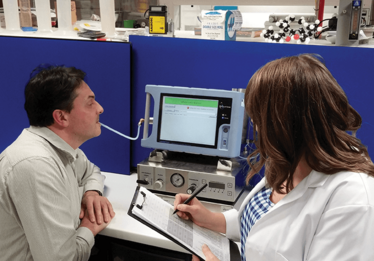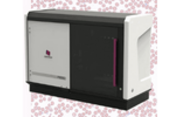High Hopes for Cancer Breathalyzer
Microchip technology can detect very low quantities of lung cancer biomarkers in breath – and may offer a new noninvasive screening option
Lung cancer is the leading cause of cancer death worldwide (1) – but a large part of the reason might be because so many patients go undiagnosed until they have advanced disease – survival is closely correlated with stage at diagnosis. Patients who present at stage I, for instance, have five-year survival rates of about 35 percent, while those presenting at stage IV rarely survive more than two years (2). It’s clear that early diagnosis is key to improving lung cancer survival rates, but that’s easier said than done. Unlike other common cancers, there’s no easy screening tool for early-stage lung cancer. The best current option is low-dose computed tomography for high-risk individuals, but this can lead to overdiagnosis of abnormalities that don’t require further investigation and also exposes patients to radiation.

Credit: Danielle Toutoungi at Owlstone, Inc.
Now there may be an alternative. Engineer Billy Boyle, cofounder and president of operations at Owlstone, Ltd. (Cambridge, UK), has developed a silicon microchip with a chemical sensor capable of detecting volatile organic compound (VOC) biomarkers in very low quantities. Using field asymmetric ion mobility spectrometry (FAIMS), the chip can rapidly monitor a wide range of chemicals below part-per-billion concentrations (3). It serves as the “brains” of a breathalyzer device that can identify lung cancer biomarkers with a simple breath test. The chip has already demonstrated an ability to accurately detect 12 biomarkers in breath specimens (4), and the Lung Cancer Indicator Detection (LuCID) project has now won a £1 million SBRI Healthcare award to take its technology to clinical trials. With that funding, Boyle plans to deliver a handheld breathalyzer device that can be used in the clinic.
The FAIMS technology was originally intended for the detection of explosive devices in high-risk areas, but Boyle took things in a different direction after his wife’s cancer diagnosis in 2012. In a press release from Owlstone, he said, “If you could change only one thing in the fight against cancer, it would be to detect the disease earlier where existing treatments are already proven to save lives. FAIMS technology has the potential to bring a quick and easy-to-use breath test to a GP’s office. Our team will not rest until we help stop the daily devastation that cancer brings to patients and their families.”
- Cancer Research UK, “Twenty most common causes of cancer death” (2012). Available at: bit.ly/1KW3Os0. Accessed June 10, 2015.
- Cancer Research UK, “Lung cancer survival by stage at diagnosis” (2006). Available at: bit.ly/1QoJ7eW. Accessed June 10, 2015.
- AA Shvartsburg, et al., “Ultrafast differential ion mobility spectrometry at extreme electric fields in multichannel microchips”, Anal Chem, 81, 6489–6495. PMID: 19583243.
- Owlstone, Inc., “Owlstone’s LuCID project wins £1M NHS funding to save lives by improving detection rates of early stage cancer” (2015). Available at: bit.ly/1TbpKVH. Accessed June 10, 2015.

While obtaining degrees in biology from the University of Alberta and biochemistry from Penn State College of Medicine, I worked as a freelance science and medical writer. I was able to hone my skills in research, presentation and scientific writing by assembling grants and journal articles, speaking at international conferences, and consulting on topics ranging from medical education to comic book science. As much as I’ve enjoyed designing new bacteria and plausible superheroes, though, I’m more pleased than ever to be at Texere, using my writing and editing skills to create great content for a professional audience.




















